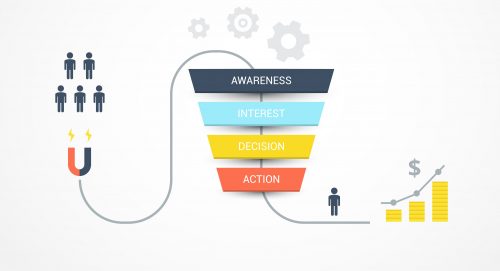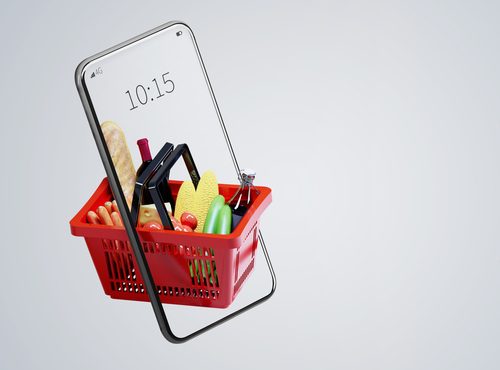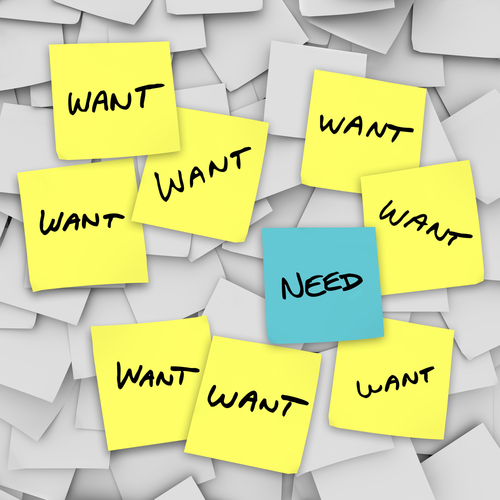Every merchant/ enterprise works towards getting more visitors to their ecommerce store. Increased website traffic is a welcome situation, but such visitations will only be meaningful if that visitor can be converted into a paying customer.
Educational Insights tell us that on an average, only about 3% of the total visitors to your website will actually complete the transaction and become a customer!
That is to say that on an average, only 3 out of the 100 visitors who came to your store actually ended up as a customer. Not a very encouraging statistic for sure, but is there any way to try and grow the number of conversions?
Yes, there are a few actions that the merchant could work on, out of which, one of the most effective ways would be by trying to optimize his Conversion Funnel.
What is a Conversion Funnel?

The Conversion Funnel is a popular concept in E Commerce used to represent the customer’s journey from browsing for a product at your website to ultimately converting it to a revenue generating transaction.
The “funnel” is representative of the path customers go through before finally buying, and is representative of the steadily declining number of potential customers as they move through this conversion path.
Every merchant will have a different conversion funnel depending on how users navigate their business. Usually, the funnel is longer for more expensive products, while lower cost items have a shorter conversion funnel (with price being less of an obstacle to buy the product) .
Understanding the Stages of the funnel
There are a few different stages of each buyer’s journey at your webstore. To keep matters simple, here we highlight three distinct stages which can sometimes be classified into sub-stages if necessary.
The first stage is Awareness. This is where the visitor is likely to do preliminary research about the product. Yours can be one among the many products that the customer is looking at.
This is followed by Interest. Here the visitor is getting more specific and showing more interest towards a particular product. He is likely to be conducting a more detailed research and looking at reviews and other feedback available. A bit of nurturing by sharing useful and relevant educational content with the visitor at this stage helps.
This is followed by Action, where the visitor has made the decision and adds your product to the shopping cart. However, the transaction is considered to be complete only when he makes the payment and arranges for shipping and delivery.
How to get to know about these stages?

Technology is there to help and all such data that is essential to optimize your conversion funnel and understand the audience is available to every ecommerce store from Google Analytics.
Integrating Google Analytics to your Shopmatic webstore (by adding the Tracking Code and Saving it) will allow you to access all the data and information that you are looking for from the Shopmatic dashboard.
This allows you to monitor the Conversion Funnel and understand the behaviour of your potential customers. It also provides clarity and insights on how your customers interact with your product and brand.
How does it help?
Having a good knowledge of the Conversion Funnel at your store and building it up is very helpful as it allows you to map the buyer’s journey and understand and identify what you can do at each stage to ensure a conversion. It helps you understand the customer’s behaviour better and do whatever is necessary and possible to improve their overall experience at your webstore. This then increases the chances of them converting from a mere visitor to a paying customer.
Understanding what works

Let’s look at some valuable information gathered from the Conversion funnel analysis, that can help reinforce your targeted marketing efforts.
The analytics data helps you understand how exactly the visitor landed at your store. This helps in recognising how and where the traffic to the site is being generated – organic search, email forward or social media? Once you have this knowledge, you can enhance your efforts towards such sources.
Knowing which areas impact conversions the most helps. If social media selling is what has been working for you, then amplify your presence on Instagram and Facebook (or whichever other platform works for you) and encourage your website visitors to follow you on that platform.
A visitor who leaves behind an email address or makes a subscription to your blogs or newsletters is surely interested in your brand and product. It makes sense to categorize such visitors as leads (in your funnel) and pursue them in future.
Understanding what is triggering the transaction will allow you to plan more effective promotional campaigns in the future. Is it the discount code that you are offering for first time buyers, is it the limited 1 for 1 offer that you gave in the festive season, or is it the fancy packaging and free delivery that you are offering beyond a minimum purchase?
All of this is valuable information and can help you to maximize your sales.
Understanding the actions of the visitors

Let’s start at the top of the funnel where your website receives a large number of visitors from various channels. People visit the store but then bounce off. Why is this happening?
When visitors drop off right at the awareness stage (which usually sees the biggest drop) one can assume that the products that he viewed probably did not meet his requirements and expectations.
The customer is already showing an interest in your product and a desire to acquire it as they move to the next stage of the funnel. If they are dropping off at the Interest stage, there could be a host of reasons ranging from navigational issues to having problems in finding the right product that they are looking for. Are they finding the site confusing? Can the language and copy be made more customer friendly? Are there navigation issues?
Action involves the checkout and payment process and is the culmination of the journey. This is an extremely important point as many things can go wrong here. If they are putting items into their carts and then abandoning them – you need to explore why it is happening. Is the checkout process best optimized? Are there enough payment and delivery options available? Or is it some other reason that if corrected can prevent similar cart abandonments in future!
Delving deeper to understand the reason behind each of the situations discussed above can be very insightful for the merchant. It provides directions and pointers on how to correct/ tweak the situation to prevent the visitor from dropping off without completing the transaction.
Understand your Conversion Funnel well

Understanding the Conversion Funnel is very useful for any online retailer as it can help increase sales and revenues.
Data provided by tools like Google analytics is able to lend insights on a wide range of areas related to your potential customer’s journey at your store.
Careful consideration of such insights allows you to give them a better customer experience at the store which enhances their chances of conversion, thereby fulfilling the goal of converting a visitor to a paying customer!


